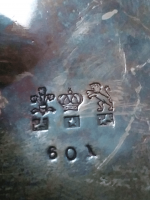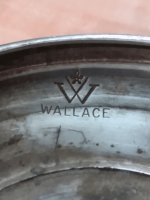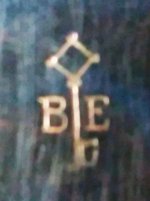Navigation
Install the app
How to install the app on iOS
Follow along with the video below to see how to install our site as a web app on your home screen.
Note: This feature may not be available in some browsers.
More options
You are using an out of date browser. It may not display this or other websites correctly.
You should upgrade or use an alternative browser.
You should upgrade or use an alternative browser.
Need help Identifying hallmarks
- Thread starter basssmann
- Start date
- Oct 26, 2004
- 24,642
- 24,441
- 🏆 Honorable Mentions:
- 2
- Detector(s) used
- Minelab Explorer
- Primary Interest:
- Shipwrecks
Wallace Silversmiths
From 1956
Wallingford, Connecticut
Don...
From 1956
Wallingford, Connecticut
Don...
Red-Coat
Gold Member
Just browsing around and I noticed that only one of your three marks had been identified. You might have made it clearer that you were showing marks from three different and unrelated pieces.
The answer to your question is an emphatic ‘no’… lions and/or crowns are most certainly not a reliable indication for Sterling silver. British hallmarks for Sterling follow a legislated format that specifies a set of compulsory marks, for which the lion passant designates Sterling (not a lion rampant as you are showing) and the crown designates the Sheffield assay office. Especially after the appearance of electro-plate in the 1840s, many manufacturers applied marks with similarities to our official hallmarks as a cynical way to enhance their appeal to customers.
Your first mark is a classic example. The array of marks with plumes, crown and lion is designed to look impressive, with mimicry of the kinds of symbols seen on British Sterling silver, but they’re pseudo-hallmarks for American silver plate. The maker is E.G. Webster and Son of New York and Brooklyn, founded in 1860 by Elizur G. Webster. Those particular marks date between 1886-1928 as Webster & Son but continued to be used after that date when the company became part of the International Silver Company until their trademark was changed to Webster Wilcox in 1961.
The second mark is, as said, for Wallace Silversmiths, originally founded as Robert Wallace in 1834 in Wallingford, Connecticut. After a couple of name changes, they became ‘Wallace Silversmiths’ in 1956. That particular mark was used on both silverplate and Sterling, but Sterling pieces would be additionally marked with the word ‘Sterling’ and/or ‘925’.
The third mark is for Arthur Krupp Metallwarenfabrik, founded in 1843 in Berndorf, Austria but with later factories in Esslingen, Germany and Milan, Italy. The key mark with the ‘BE’ initials is for the Esslingen factory and dates to c1919-1927. It’s a rarely-seen mark used for their high-quality silver-plated (Alpacca-Silber I) items.
PS: If you have other items that need identifying, it usually helps if you show the piece itself rather than just the mark(s). That often helps narrow down the country where the piece was made (and sometimes the timeframe) and reduces the amount of searching to find the mark.
The answer to your question is an emphatic ‘no’… lions and/or crowns are most certainly not a reliable indication for Sterling silver. British hallmarks for Sterling follow a legislated format that specifies a set of compulsory marks, for which the lion passant designates Sterling (not a lion rampant as you are showing) and the crown designates the Sheffield assay office. Especially after the appearance of electro-plate in the 1840s, many manufacturers applied marks with similarities to our official hallmarks as a cynical way to enhance their appeal to customers.
Your first mark is a classic example. The array of marks with plumes, crown and lion is designed to look impressive, with mimicry of the kinds of symbols seen on British Sterling silver, but they’re pseudo-hallmarks for American silver plate. The maker is E.G. Webster and Son of New York and Brooklyn, founded in 1860 by Elizur G. Webster. Those particular marks date between 1886-1928 as Webster & Son but continued to be used after that date when the company became part of the International Silver Company until their trademark was changed to Webster Wilcox in 1961.
The second mark is, as said, for Wallace Silversmiths, originally founded as Robert Wallace in 1834 in Wallingford, Connecticut. After a couple of name changes, they became ‘Wallace Silversmiths’ in 1956. That particular mark was used on both silverplate and Sterling, but Sterling pieces would be additionally marked with the word ‘Sterling’ and/or ‘925’.
The third mark is for Arthur Krupp Metallwarenfabrik, founded in 1843 in Berndorf, Austria but with later factories in Esslingen, Germany and Milan, Italy. The key mark with the ‘BE’ initials is for the Esslingen factory and dates to c1919-1927. It’s a rarely-seen mark used for their high-quality silver-plated (Alpacca-Silber I) items.
PS: If you have other items that need identifying, it usually helps if you show the piece itself rather than just the mark(s). That often helps narrow down the country where the piece was made (and sometimes the timeframe) and reduces the amount of searching to find the mark.
Last edited:
Top Member Reactions
-
 3569
3569 -
 1971
1971 -
 1825
1825 -
 1208
1208 -
 1138
1138 -
 1014
1014 -
 883
883 -
 855
855 -
 819
819 -
 794
794 -
 744
744 -
 664
664 -
 577
577 -
 567
567 -
 502
502 -
 466
466 -
 424
424 -
E
417
-
 407
407 -
 404
404
Users who are viewing this thread
Total: 2 (members: 0, guests: 2)









